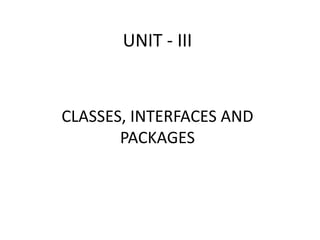Class is a blueprint for creating objects that share common attributes and behaviors. A class defines the data and methods that describe the object. Classes in Java can contain data members, methods, constructors, nested classes, and interfaces. Objects are instances of classes that occupy memory at runtime and can access class members like variables and methods. Constructors initialize an object when it is created and have the same name as the class. The this keyword refers to the current object in a method or constructor. Command line arguments can be passed to a program as strings and accessed via the args parameter in the main method.







![Accessing class members:
obj_name.var_name;
obj_name.method_name();
Example:
class Student
{
int id;//data member (also instance variable)
String name; //data member (also instance variable)
public static void main(String args[])
{
Student s1=new Student();
//creating an object of Student
System.out.println(s1.id);
System.out.println(s1.name);
}
}](https://image.slidesharecdn.com/unit-iiinew-230211045021-96dc1912/85/UNIT-IIInew-pptx-8-320.jpg)
![Creating Array of objects
• Using arrays, more than one object for the
same class can be created.
Syntax:
class_name object[]=new class_name[size];
(or)
class_name [] object=new class_name[size];](https://image.slidesharecdn.com/unit-iiinew-230211045021-96dc1912/85/UNIT-IIInew-pptx-9-320.jpg)


![Java Default Constructor
A constructor is called "Default Constructor" when it doesn't have any parameter.
Syntax of default constructor:
<class_name>(){}
Example:
class Bike1{
//creating a default constructor
Bike1(){
System.out.println("Bike is created");
}
//main method
public static void main(String args[])
{
//calling a default constructor
Bike1 b=new Bike1();
}
}](https://image.slidesharecdn.com/unit-iiinew-230211045021-96dc1912/85/UNIT-IIInew-pptx-12-320.jpg)
![Java Parameterized Constructor
A constructor which has a specific number of parameters is called a parameterized
constructor.
The parameterized constructor is used to provide different values to distinct
objects.
class Student4{
int id;
String name;
//creating a parameterized constructor
Student4(int i,String n){
id = i;
name = n;
}
//method to display the values
void display(){System.out.println(id+" "+name);}
public static void main(String args[]){
//creating objects and passing values
Student4 s1 = new Student4(111,"Karan");
Student4 s2 = new Student4(222,"Aryan");
//calling method to display the values of object
s1.display();
s2.display();
} }](https://image.slidesharecdn.com/unit-iiinew-230211045021-96dc1912/85/UNIT-IIInew-pptx-13-320.jpg)



![class demo {
private int m, n;
demo(int x, int y)
{ m = x;
n = y; }
int largest()
{
if (m > n) return m;
else return n; }
void display()
{ int large=largest();
System.out.println("The Greatest Number is : "+large); } }
public class nested_method {
public static void main(String args[]) {
demo o =new demo(10,20);
o.display(); } }](https://image.slidesharecdn.com/unit-iiinew-230211045021-96dc1912/85/UNIT-IIInew-pptx-17-320.jpg)

![class Student{
int rollno;
String name;
float fee;
Student(int rollno,String name,float fee){
this.rollno=rollno;
this.name=name;
this.fee=fee;
}
void display(){System.out.println(rollno+" "+name+" "+fee);}
}
class TestThis2{
public static void main(String args[]){
Student s1=new Student(111,"ankit",5000f);
Student s2=new Student(112,"sumit",6000f);
s1.display();
s2.display();
}}](https://image.slidesharecdn.com/unit-iiinew-230211045021-96dc1912/85/UNIT-IIInew-pptx-19-320.jpg)
![Command line argument
• The java command-line argument is an argument
i.e. passed at the time of running the java program.
• The arguments passed from the console can be
received in the java program and it can be used as
an input.
class CommandLineExample{
public static void main(String args[])
{
System.out.println("Your first argument is: "+args[0]);
}
}](https://image.slidesharecdn.com/unit-iiinew-230211045021-96dc1912/85/UNIT-IIInew-pptx-20-320.jpg)